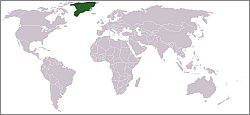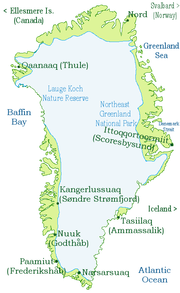Greenland
|
|
- For other uses, see Greenland (disambiguation).
Greenland (Greenlandic: Kalaallit Nunaat, "The Land of the Greenlanders (Kalaallit)"; Danish: Grønland) is a self-governed Danish territory and an Arctic island nation located in North America with shores on the North Atlantic Ocean and the Arctic Ocean. It is the world's largest island. About 81 percent of its surface is covered by ice. It is the largest dependent territory in the world.
Greenland was one of the Norwegian Crown colonies until 1815, when it formally became a Danish colony, although Norway and Denmark had been in a personal union for centuries. Greenland became an integral part of the Kingdom of Denmark in 1953. It was granted home rule (hjemmestyre) by the Folketing (Danish parliament) on May 1 1979. The law went into effect the following year. The Queen of Denmark, Margrethe II, remains Greenland's Head of state.
| ||||
| Motto: None | ||||
 | ||||
| Official languages | Kalaallisut, Danish | |||
| Capital | Nuuk (Godthåb) | |||
| Monarch | Margrethe II | |||
| Prime Minister | Hans Enoksen | |||
| Area - Total - % ice | Ranked 14th 2,166,086 km² 81.1% | |||
| Population - Total (2003) - Density | Ranked 210th 56,385 0.2/km² | |||
| Independence | None (Danish dependency. Self-governing since 1979.) | |||
| Currency | Danish krone | |||
| Time zone | UTC 0 to -4 | |||
| National anthem | Nunarput utoqqarsuanngoravit Nuna asiilasooq | |||
| Internet TLD | .gl | |||
| Calling Code | 299 | |||
| Contents |
History
Main article: History of Greenland
Greenland was home to a number of Palaeo-Eskimo cultures in prehistory, the latest of which - the Early Dorset culture - disappeared around AD 200. Hereafter, the island seems to have been without humans for some eight centuries.
Icelandic settlers found the land uninhabited when they arrived ca. AD 982. They established three settlements near the very southwestern tip of the island, where they thrived for the next few centuries.
The name Greenland comes from those Scandinavian settlers. In the Norse sagas, it is said that Eiríkur Rauði (Erik the Red) was exiled from Iceland for murder. He, along with his family and slaves, set out in ships to find the land that was rumoured to be to the north-west. After settling there, he named the land Greenland in order to attract more people to settle there. The fjords of the southern part of the island are lush. This proved successful, and the settlements seemed to be getting relatively well along with the new coming Inuit, bearers of the Thule culture, who had arrived in Northern Greenland from the west around AD 1200, and a Christian bishop was sent. In 1386, Greenland became part of the Kingdom of Norway, which were part of the Kalmar Union and later of the double monarchy of Denmark-Norway.
After almost five hundred years, the settlements simply vanished, probably due to famine during the 15th century in the Little Ice Age, when climatic conditions deteriorated. Bones from this late period were found to be in a condition consistent with malnutrition.
Denmark attained possession of the moribund colony at the Treaty of Kiel in 1815.
Norway occupied and claimed parts of (then uninhabited) Eastern Greenland in the 1920s, claiming that it constituted Terra nullius. Norway and Denmark agreed to settle the matter in the International Court of the League of Nations in 1933, where Norway lost.
Greenland was also called Gruntland ("Ground-land") on early maps. Whether Green is an erroneous transcription of Grunt ("Ground"), which refers to shallow bays, or vice versa, is not known.
During World War II, Greenland was on its own, the connection to Denmark having been cut on April 9, 1940 when Denmark was occupied by Germany. Through the cryolite from the mine in Ivigtut, Greenland was able to pay for goods bought in the United States and Canada. The manner in which Greenland had been run prior to the war was altered.
The Sledge Patrol guarding the Northeastern shores of Greenland was founded in 1941 and participated in defeating the Germans, which gave Denmark a better position in the postwar turmoil. In 1953 Greenland was made an equal part of the Danish Kingdom. In 1979 Greenland took one step further when home rule was started.
During the War Eske Brun was govenor and ruled the Island via a 1925-law concerning the governing of the Island where under extreme circumstances the governors could take control. The other govenor Aksel Svane was transferred to USA as leader of the supply to Greenland commission.
Politics
Greenland's Head of State is the Danish Monarch, currently Margrethe II. The Queen's government in Denmark appoints a Rigsombudsmand High commissioner representing the Danish government and monarchy.
Greenland has a 31 member elected parliament. The head of government is the Prime Minister, who is usually the leader of the majority party in Parliament.
Main article: Politics of Greenland
Geography
Main article: Geography of Greenland
Greenland_eastcoast.jpg
All towns and settlements of Greenland are situated along the ice-free coast, with the population being concentrated along the western coast. At least two scientific expedition stations had been established in the ice-covered central part of Greenland, on the icecap: Eismitte and North Ice.
The extreme north of Greenland is not covered by an ice cap (indicated as pale blue in the map to the right), because the air there is too dry to produce snow, which is essential in the production and maintenance of an ice cap.
If the Greenland ice cap were to completely melt away, Greenland would most likely be an archipelago.
Between 1989 and 1993, U.S. and European climate researchers drilled into the summit of Greenland's ice sheet, obtaining a pair of two-mile (3.2km) long ice cores. Analysis of the layering and chemical composition of the cores has provided a revolutionary new record of climate change in the Northern Hemisphere going back about 100,000 years and illustrated that the world's weather and temperature have often shifted rapidly from one seemingly stable state to another, with worldwide consequences.
Economy
Main article: Economy of Greenland
Greenland suffered economic contraction in the early 1990s, but since 1993 the economy has improved. The Greenland Home Rule Government (GHRG) has pursued a tight fiscal policy since the late 1980s which has helped create surpluses in the public budget and low inflation. Since 1990, Greenland has registered a foreign trade deficit following the closure of the last remaining lead and zinc mine in 1990. Greenland today is critically dependent on fishing and fish exports; the shrimp fishery is by far the largest income earner. Despite resumption of several interesting hydrocarbon and mineral exploration activities, it will take several years before production can materialize. Tourism is the only sector offering any near-term potential and even this is limited due to a short season and high costs. The public sector, including publicly owned enterprises and the municipalities, plays the dominant role in Greenland's economy. About half the government revenues come from grants from the Danish Government, an important supplement of GDP.
Demographics
Main article: Demographics of Greenland
Culture
Main article: Culture of Greenland
The Greenland National Museum and Archives[1] (http://www.natmus.gl) is located in Nuuk.
Miscellaneous topics
- Communications in Greenland
- Transportation in Greenland
- Military of Greenland
- Foreign relations of Greenland
- List of universities in Greenland
See also
- Danish colonization of the Americas
- History of Denmark
- Danish West Indies
- Danish India
- Ellesmere Island
- Svalbard
- Cape Morris Jesup
- Oodaaq
- Kaffeklubben Island
- Ultima Thule search
References
- CIA World Factbook 2000
External links
- Greenland Homerule (http://dk.nanoq.gl/changelang.asp?lang=en) - Official site
- Greenland (http://www.cia.gov/cia/publications/factbook/geos/gl.html) - CIA World Factbook
- Statistics Greenland (http://www.statgreen.gl/)
| Nordic Council | 
|
|---|---|
| Denmark | Finland | Iceland | Norway | Sweden | |
| Associate members | |
| Åland | Faroe Islands | Greenland | |
| Countries in North America |
|---|
| Antigua and Barbuda | Bahamas | Barbados | Belize | Canada | Costa Rica | Cuba | Dominica | Dominican Republic | El Salvador | Grenada | Guatemala | Haiti | Honduras | Jamaica | Mexico | Nicaragua | Panama | Saint Kitts and Nevis | Saint Lucia | Saint Vincent and the Grenadines | Trinidad and Tobago | United States |
| Dependencies: Anguilla | Aruba | Bermuda | British Virgin Islands | Cayman Islands | Greenland | Guadeloupe | Martinique | Montserrat | Navassa Island | Netherlands Antilles | Puerto Rico | Saint-Pierre and Miquelon | Turks and Caicos Islands | U.S. Virgin Islands |
af:Groenland ang:Gréneland ca:Grenlàndia cs:Grónsko cy:Grønland da:Grønland de:Grönland et:Gröönimaa es:Groenlandia eo:Gronlando fa:گرینلند fo:Grønland fr:Groenland gl:Grenlandia - Kalaallit Nunaat id:Greenland ia:Groenlandia iu:ᐊᑯᑭᑦᑐᑦ it:Groenlandia he:גרינלנד kl:Kalaallit Nunaat la:Groenlandia lt:Grenlandija zh-min-nan:Chheⁿ-tē nl:Groenland nds:Gröönland ja:グリーンランド nb:Grønland nn:Grønland pl:Grenlandia pt:Gronelândia ro:Groenlanda ru:Гренландия simple:Greenland sk:Grónsko sl:Grenlandija fi:Grönlanti sv:Grönland tr:Grönland zh:格陵兰


